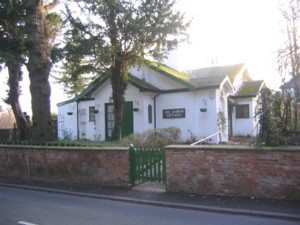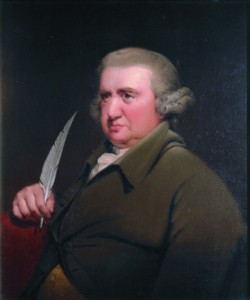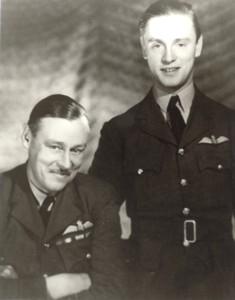
The Darwins and Elston Hall
The Darwins
The Darwins’ long association with Elston began in 1680 when William Darwin of Cleatham in North Lincolnshire married Anne Waring, the stepdaughter of George Lascelles of Elston. She was the only daughter and heiress of Robert Waring of Wilford by his wife Anne, who married secondly George Lascelles of Elston in 1666. George Lascelles died in 1680 leaving his Elston estates to his son, John Lascelles, who inherited the estate on his 21st birthday in 1691 but died the following year. In his will John left his mother with a life interest in the property, but on her death it would pass to the Lascelles family. William Darwin died in 1682 after only two years of marriage leaving two sons, William and Robert. Anne Darwin and her sons lived with her mother, Anne Lascelles at Elston. When Anne Lascelles died in 1708 the estate should have passed to the Lascelles family. However Robert Darwin, a lawyer and second son of William Darwin and Anne Waring, bought out the interests of the Lascelles family and the estate passed to the Darwins. However the Darwins had also agreed to pay the still outstanding legacies of George Lascelles from 1680 amounting to £1000, and so began three years of negotiations with the Lascelles which finally resulted in a court action in 1711 that the Darwins lost and were then forced to pay the money.

The Darwins made several charitable bequests to the parish. By her will of 1722 Ann Darwin left money to build an almshouse for four poor widows who were to have, amongst other things, a grey coat or gown with a red badge marked A.D. (for Ann Darwin) on the right sleeve. The building was erected in 1744, rebuilt in 1834, and still stands in Top Street opposite the church. The four residences are still occupied, but the wearing of the grey coat has long since ceased to be a requirement. Above the centre door is a Latin motto – Aeque pauperibus prodest locupletibus aeque -- meaning “It is equally of advantage to both the poor and the rich”. The poor lived there and the rich had an opportunity to be generous.
William Darwin’s eldest son, William, inherited the Cleatham estates. Robert Darwin’s eldest son, another Robert, succeeded him on his death in 1754 to the Elston Estate. He was a keen botanist and wrote a "Principia Botanica", which reached a third edition, and was printed by Hage of Newark. It was dedicated to his nephew, Robert Waring Darwin, M.D., F.R.S., (father of the naturalist Charles Darwin) and bears on the title page the appropriate quotation from 1 Kings IV, 33, "And He spake of trees, from the cedar that groweth in Lebanon, even unto the hyssop that springeth out of the wall." The manuscript of this work is in a beautiful handwriting, and it is humourously said that the author would have this book published because he could not bear to think that so much fine calligraphy should be wasted. In the preface, which is dated from Elston, he expresses the hope that some able inquirer will investigate the analogy between vegetables and minerals, and see whether by inspecting the plants which grow on the surface of any place the quality of the soil may be discovered, as also the several sorts of minerals it may contain. He remained a bachelor and died at Elston in his 92nd year in 1816.

William’s fourth son was Erasmus Darwin, who was born at Elston Hall in 1731. Erasmus became a doctor but had no success in Nottingham so he moved to Lichfield, where he became recognised as the finest physician in England with a reputation of giving poor patients food and blankets instead of charging fees. His very long poem “The Botanic Garden” won him great fame in his lifetime. He had wonderful powers of observation and he invented and suggested many domestic and industrial machines including a guided missile, a horizontal windmill, a canal lift, and a speaking machine (which operated by passing air through organ reeds and was ingeniously timed to simulate the tones of his father and which could even recite the Lord’s Prayer). He was a contemporary of James Watt, Matthew Boulton, Joseph Priestley and Benjamin Franklin and was a founder member of the Lunar Society. And two generations before his grandson Charles Darwin wrote “The Origin of Species” (1859), Erasmus Darwin had already formed radical views on evolution. Charles would probably have visited Elston but never lived at the Hall. A bronze bust of Erasmus Darwin was installed near the altar in Elston Church in 2002 to commemorate the 200th anniversary of his death.

Charles Waring Darwin was born in 1851. He was a cousin to Charles Darwin, the naturalist, who was his godfather. A soldier in the Durham Light Infantry, he served in India and South Africa. In 1894 he married Mary Dorothea Wharton, the only child of Rt Hon John Lloyd Wharton MP for Durham. They had three children – John, Francis, and Gilbert. The Colonel, as he was known, took an almost feudal interest in the church, checking on who attended regularly, and a paternal interest in the school, where he was a frequent visitor. In 1928 he donated land to the school for a playground and Dorothea provided swings and a seesaw. Charles Waring Darwin died in Wiesbaden aged 72 on 2nd August 1928.

Charles John Wharton Darwin D.S.O. (shown here with son Christopher) was born at Dryburn Hall near Durham on 12th December 1894, the son of Charles Waring and Mary Dorothea Darwin. Educated in Germany, Switzerland, Broadstairs, and Winchester, he joined the army in 1912 and transferred to the Royal Flying Corps in 1916, which in 1918 became the Royal Air Force. He accompanied Churchill at the Paris peace talks and in 1920 became one of the first flying instructors at RAF Cranwell. He resigned his commission in 1928 but was retained by the Secret Intelligence Service. He joined the Bristol Aircraft Company and later Saunders Roe, travelling all over the world, probably in part for the SIS. In 1939 he helped set up Bletchley Park and then travelled in Europe briefing agents and setting up a chain of radio transmitters. Charles John Wharton Darwin or John, as he was known in the family, kept a diary from 1939. In 1940 he left the SIS and rejoined the RAF, being posted to RAF Kinloss near Inverness. In April 1941 he became ill and died on Boxing Day of the same year.

Sybil Rose met Charles John Wharton Darwin in 1914. They married in 1917 before he left to return to France. They had three children – Christopher, Vivien, and Susan. Christopher narrowly escaped death in a flying accident in July 1940 but died on active service in August 1942 at El Alamein. He is buried at El Alamein Cemetery. The memorials of Charles and Christopher Darwin are in the south aisle of All Saints Church, which contains many monuments to members of the Darwin family dating from the 18th century. The family still maintains contact with the village through John Christopher Darwin, who is patron of All Saints Church.
Elston Hall

Little is recorded about Elston Hall and even less is known of the manor house that formerly stood on the site. This engraving from 1754 shows the Hall after Robert Waring Darwin inherited the Elston estate from his father. In 1756 he modernised Elston Hall by re-building the present front façade. The rear elevation and much of the interior of the house took their present form when Robert Brown Darwin carried out extensive alterations in 1837. The oval lawn was created at this time and Top Street was moved back to form the curve we see today, with some cottages being demolished in the process, and the northern façade became the front entrance. Until then the approach had been to what is now the back of the Hall via Syerston. Elston Lodge on the Fosse Way was built in 1801 by William Brown Darwin as a place to shelter overnight when awaiting the arrival of the London coach which would stop there at 5 in the morning. Sometimes the coach was full and he would have to return home three quarters of a mile up the Lane. The stable block was added in 1851 by Francis Rhodes Darwin, who married in 1849, Charlotte Maria Cooper Darwin, the heir of Robert Brown Darwin. Other alterations to the front garden were made at the end of the 19th century and around 1950.
In 1934 the family moved to a new house they had built at Oxton and the hall was let to Mr Sydney Shepard, founder of Bairnswear and MP for Newark. The estate, comprising a number of surrounding farms and several cottages in the village, was sold at auction in September 1945 by Vivien Kindersley, daughter of Charles John Wharton Darwin, who had inherited the estate on the death of his father in 1928. However the Hall itself and 42 acres of adjacent land remained in the Darwin family until 1954 when their tenant, Sydney Shepard, died. The Hall was then sold and became a Catholic boarding school, and two wings were added in the 1960s to either side to accommodate the boarders. The school closed in 1970, remaining empty until 1976 when it was bought by a developer and converted into ten dwellings.
A large sycamore tree with three main branches, known as the candelabra tree, stood in front of the house until 2002 when its centre came down in a gale. The rings showed that it had been alive possibly at the time of the French Revolution in 1789 and certainly at the time of Waterloo in 1815. A large copper beech in the back garden of No 6 and known as the Darwin Beech contracted a disease in its roots and had to be felled in 2007.

